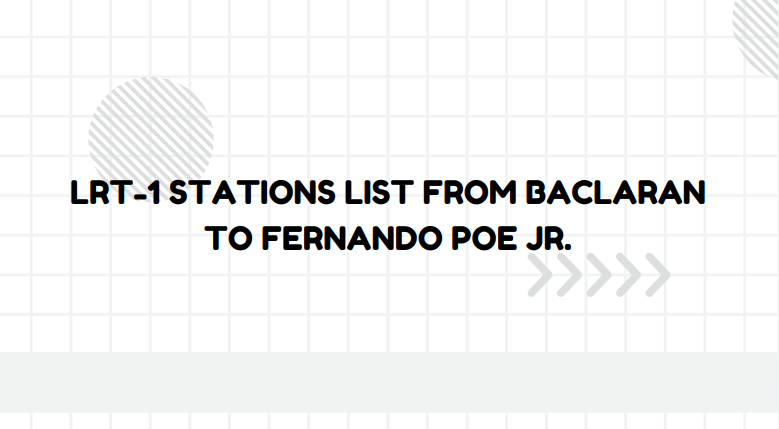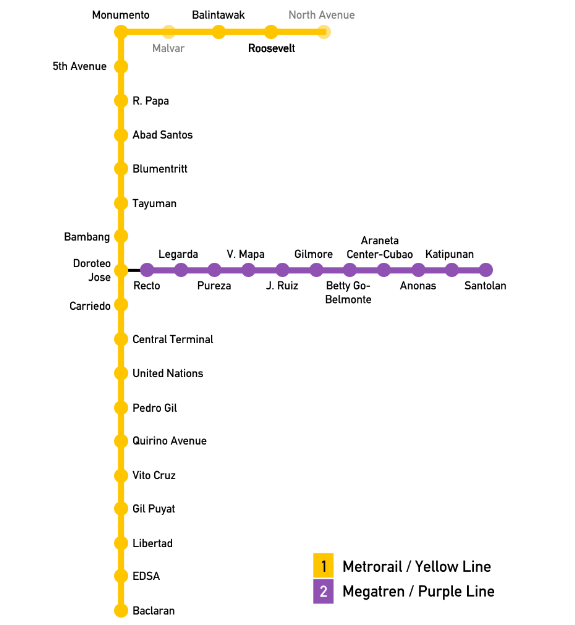Navigating Metro Manila’s bustling streets can be a daunting task, but the LRT-1 offers a streamlined solution with its well-placed stations stretching from Baclaran to Fernando Poe Jr. This light rail line, affectionately known as the Green Line, provides a crucial link across the sprawling metropolis, connecting diverse neighborhoods and essential destinations. As a key component of the city’s public transportation network, LRT-1 facilitates easier commutes and enhances connectivity throughout Metro Manila.
From its southern terminus at Baclaran, a vibrant hub of activity and commerce, to the northern endpoint at Fernando Poe Jr., each LRT-1 station serves a unique role in the urban landscape. This guide will take you through each station, highlighting their key features and the significant locations they connect. Whether you’re a daily commuter or a first-time rider, understanding the LRT-1 stations list can greatly enhance your travel experience across one of Southeast Asia’s busiest cities.

Navigating Metro Manila, particularly in the National Capital Region (NCR), can be a stressful experience. Whether it’s sitting for long periods in a jeepney surrounded by traffic or dealing with the intense heat and pollution, commuting in the city is often unpleasant. For those who prefer more comfort, taking a taxi or using a Grab service comes at an extra cost, but it doesn’t spare you from the notorious traffic jams.
Amid this transportation chaos, the LRT-1 offers a bit of relief. Catering to around 275,000 passengers daily, it stands as one of the most reliable public transit systems in the metro. Though the trains can get crowded, they are a dependable means of getting to your destination efficiently. For both newcomers to the Philippines and locals exploring Manila for the first time, knowing the LRT-1 stations can make navigating the city much smoother.
What is LRT-1 and Where is It?
Goldpriceph.com – The Light Rail Transit Line 1 (LRT-1) is one of Metro Manila’s major rapid transit systems, operated by the Light Rail Manila Corporation (LRMC). Commonly known as the Green Line, it plays a vital role in the city’s transportation network, connecting four key cities: Pasay, Manila, Caloocan, and Quezon City. Alongside other rail systems such as the LRT-2, MRT-3, and the Philippine National Railways (PNR), the LRT-1 is an essential part of the public transit infrastructure that helps ease the flow of daily commuters in the capital.
LRT-1 holds historical significance as the first light rail system in Southeast Asia, providing an efficient mode of transport since its opening. Its route serves some of the most densely populated and bustling areas in the metro, offering a convenient alternative to the heavy road traffic that often plagues the city. By linking several major cities, it ensures that residents and visitors alike can travel faster and more comfortably across Metro Manila.

LRT-1 Stations in Order: Key Stops
The LRT-1 currently has 20 stations, all of which are located in essential parts of the cities it serves. Understanding the station layout helps travelers get around quickly and efficiently. From Baclaran to Fernando Poe Jr. (formerly known as Roosevelt), here is the complete list of LRT-1 stations:
- Baclaran Station – The southernmost stop and one of the busiest, Baclaran is a hub for commuters heading north. It’s located near the famous Baclaran Flea Market, the Redemptorist Church, and the SM Mall of Asia.
- EDSA Station – Situated at the intersection of EDSA and Taft Avenue, this station provides easy access to the MRT, SM Mall of Asia, and several bus terminals.
- Libertad Station – Known as Arnaiz Station, it is near major embassies and local shopping areas like Cartimar Shopping Center and the Department of Foreign Affairs.
- Gil Puyat Station – A key hub for travelers heading to Makati or major venues like the Cultural Center of the Philippines and the World Trade Center.
- Vito Cruz Station – The go-to stop for students attending De La Salle University, it’s also close to the Rizal Memorial Sports Complex and the CCP.
- Quirino Station – This station serves the Malate area and provides access to Manila Zoo and the Baywalk along Manila Bay.
- Pedro Gil Station – Located in the commercial district of Ermita, this station is near universities like Philippine Christian University and popular tourist spots like Paco Park and Robinsons Place Manila.
- UN Avenue Station – A strategic location near government buildings, including Rizal Park, the US Embassy, and the Supreme Court.
- Central Terminal Station – A great stop for those planning to explore Old Manila, as it offers proximity to historic sites like Intramuros, Fort Santiago, and various museums.
- Carriedo Station – Close to Binondo and Quiapo, this station is ideal for food lovers and shopping enthusiasts visiting Divisoria or Escolta.
- Doroteo Jose Station – A major transfer point between LRT-1 and LRT-2, providing access to Divisoria and other key shopping districts.
- Bambang Station – Serving the Sta. Cruz district, Bambang Station is near hospitals like the Jose Reyes Memorial Medical Center and the University of Santo Tomas.
- Tayuman Station – Located near the famous Dangwa Flower Market and SM City San Lazaro.
- Blumentritt Station – Connecting with the PNR, this station serves both Santa Cruz and Sampaloc districts and offers access to the Blumentritt Flea Market and Chinese General Hospital.
- Abad Santos Station – Serving both Tondo and Santa Cruz, it provides easy access to the Manila Chinese Cemetery and popular food markets in La Loma.
- R. Papa Station – The last station in Manila for those heading towards Caloocan and Quezon City.
- 5th Avenue Station – The first stop in Caloocan, located near Northern Rizal Yorkin Chinese School and several temples.
- Monumento Station – A key transit point for travelers going to Malabon, Navotas, or Valenzuela, this station is named after the Bonifacio Monument nearby.
- Balintawak Station – Serving both Quezon City and Caloocan, it connects to landmarks such as Ayala Malls Cloverleaf and Balintawak Market.
- Fernando Poe Jr. Station (formerly Roosevelt) – The northernmost stop on the line, connecting to major commercial centers like Waltermart and S&R Congressional.
Upcoming Stations: The LRT-1 Cavite Extension
The LRT-1 Cavite Extension Project is expected to expand the current network by adding eight new stations, extending the service from Baclaran to Cavite. This extension will significantly reduce travel time between Metro Manila and Cavite, with travel durations expected to be as short as 25 to 30 minutes. The upcoming stations include:
- Redemptorist Station
- Manila International Airport Station (MIA)
- Asiaworld Station
- Ninoy Aquino Station
- Dr. Santos Station
- Las Piñas Station
- Zapote Station
- Niog Station
Once completed, the LRT-1 system will have 28 stations, covering more ground and providing faster travel options for commuters heading to and from the southern parts of Luzon.
Conclusion
The LRT-1, stretching from Baclaran to Fernando Poe Jr. stations, remains a crucial backbone of Metro Manila’s public transportation system. This line covers key areas of the metropolis, providing commuters with an efficient and accessible means of travel. From bustling commercial hubs to residential neighborhoods, each station on this line serves as an important stop, catering to thousands of passengers daily. The line’s reach across Pasay, Manila, Caloocan, and Quezon City significantly eases the challenges of daily commuting in one of the busiest urban centers in the country.
As the city continues to grow, the LRT-1 line’s importance becomes even more pronounced. By serving a wide range of areas and offering a reliable transport alternative, it plays an essential role in alleviating traffic congestion and promoting sustainable urban mobility. Whether for work, school, or leisure, the stations from Baclaran to Fernando Poe Jr. stand as vital points in Metro Manila’s journey toward improving its public transit system.





